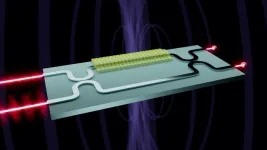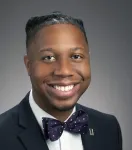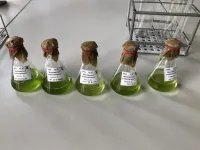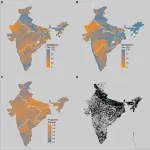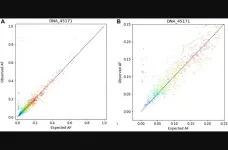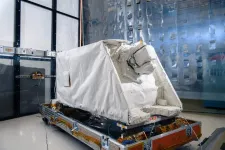(Press-News.org) At the atomic and subatomic scales exist behaviors that have vast potential to enhance how we see and interact with the world, by improving current technologies and potentially giving rise to new ones. The main advantage to be gained from the realm of quantum sensing is its extreme sensitivity and accuracy, able to capture the faintest of signals and measure at the smallest of scales.
Now, several UC Santa Barbara researchers are poised to deploy their expertise in quantum science as part of the U.S. National Science Foundation’s (NSF) program Quantum Sensing Challenges for Transformational Advances in Quantum Systems (QuSeC-TAQS). They join a cohort of 18 research teams at universities across the U.S. backed by a $29 million investment from NSF to explore ways to harness the infinitesimal and sometimes counterintuitive quantum-scale properties of nature to create opportunities at the human scale.
The teams will each receive $1 million to $2 million over four years to conduct a broad range of exploratory research activities. The potential impacts are diverse, from the ability to sense gravitational waves as they ripple across space, to a means for witnessing the inner functions of living cells.
“For decades, scientific exploration at the quantum scale has yielded surprising discoveries about how our universe works — and tantalizing possibilities for quantum enabled technologies,” said NSF Director Sethuraman Panchanathan. “We are now taking the next step in quantum research through these projects and others, which combine fundamental research with potential applications that can positively impact our lives, our economic prosperity and our competitiveness as a nation.”
A quantum-enhanced optical magnetometer: Galan Moody and Paolo Pintus
As the name suggests, a magnetometer measures a magnetic field, and in doing so provides important information about targets in relationship to that field. A compass is a simple such device, revealing information about one’s direction relative to the Earth’s magnetic field. Scientists continue to leverage the elegant power of that technology in a growing list of applications, from archaeology to space exploration.
Electrical and computer engineering Professor Galan Moody and scientist Paolo Pintus aim to bring the high precision of quantum sensing to magnetometry, and build it all onto a chip. Think about LIGO, the laser interferometer that in 2015 detected the slightest of undulations generated by gravitational waves originating 1.3 billion light years away. The team will build an analogous interferometer experiment on a semiconductor chip that, rather than gravitational waves, can detect the slightest variations in magnetic fields.
“Instead of kilometer-scale detectors, we have millimeter-scale detectors,” said Pintus, who specializes in integrated optics. Their proposed photonic integrated magneto-optic interferometer would be unprecedented in its sensitivity — a 10-time enhancement beyond the standard quantum limit — built into a compact, energy efficient device that can be used for detecting minute magnetic fields with applications for navigation, geosciences and biomedicine, as well as space exploration.
Key to this novel, low-SWaP (size, weight and power) device is the use of quantum light. “We can build on decades of research and development to make magneto-optical sensors that don’t require any other bulky instrumentation, making them compact and portable,” said Moody, whose expertise lies in quantum photonics. “Usually, these sensors are powered by lasers, but there’s a limit to their sensitivity. Instead, by using squeezed light — a special kind of quantum light source that’s less noisy than a laser — we can go beyond this limit.”
Using squeezed light enables very precise measurements of the light waves’ phase in relationship to the target while also reducing the noise that could easily obscure high-precision measurements.
As part of the project, and in collaboration with partners at University of Cagliari in Italy and Professor Caroline Ross at Massachusetts Institute of Technology (MIT), the team intends to bring on a postdoctoral fellow to assist with research and education. They will also collaborate with colleagues at NASA, Luna Innovations and Raytheon.
“We also would like to spread the knowledge about quantum sciences to a broader audience,” Pintus commented, “for both outreach and for teaching classes within the UCSB and MIT programs.” At MIT, the research team led by Ross will focus on developing materials that could host the desired qualities of sensitivity and low-power consumption, while Moody and Pintus will work on embedding squeezed light and fabrication of the actual chip, respectively, using that material.
Novel quantum algorithms for optical atomic clocks: Andrew Jayich
Optical atomic clocks are the gold standard for timekeeping; their ability to measure time at exceedingly fine intervals makes them the most precise instruments ever made. Based on the oscillations of light at the high frequencies corresponding to atomic transitions, such clocks “tick” much faster than conventional atomic clocks, which operate at microwave frequencies, and are poised to improve timekeeping and synchronization across many applications while enabling new ones.
To continue developing the potential of these ultraprecise clocks, UC Santa Barbara physics professor Andrew Jayich, alongside Kenneth Brown (Duke University), Shimon Kolkowitz (UC Berkeley), David Leibrandt (UCLA) and Marianna Safronova (University of Delaware) aim to realize new quantum algorithms for networks of optical clocks. These algorithms could enable the use of the optical clocks as sensors, turning to their exceptionally fine measurement capabilities to pick up the faintest signals from the universe.
“Roughly, atomic clocks have used the same algorithm since their inception,” said Jayich, whose research specialty lies in precision measurement with atoms and molecules. “And we want to explore new opportunities by running them with more advanced algorithms, based largely on developments in quantum information science over the last couple of decades.”
Using tools developed for quantum information science, the team intends to develop algorithms to optimize optical atomic clocks for sensing applications. They are aiming to maximize the clocks’ sensitivities to specific phenomena, such as gravitational waves or dark matter, while minimizing sensitivity to sources of noise. The algorithmic work could also help to reduce their size, weight and power requirements, which could help to realize transportable optical clocks. The project will train undergraduate and graduate students and and postdoctoral scholars in the interdisciplinary research at the forefront of quantum metrology, as well as conduct outreach to high school students to introduce them to optical clocks and precision measurement.
UC Santa Barbara researchers will also be participating in quantum sensing projects led by other universities, including:
Compact and robust quantum atomic sensors for timekeeping and inertial sensing: Dan Blumenthal
What makes quantum sensors ideal — their amazing sensitivity — also makes them vulnerable to the noise brought on by temperatures and electromagnetic fields. Electrical and computer engineering Distinguished Professor Daniel Blumenthal will work to overcome these hurdles alongside colleagues at University of Wisconsin-Madison (UW-Madison). Led by UW-Madison electrical and computer engineering Professor Jennifer Choy, the team also includes UW Professors Mikhail Kats, Mark Saffman and Swamit Tannu.
The quantum sensor of choice? Cold atoms. When atoms are cooled to almost absolute zero, they take on certain quantum properties; the challenge for the team is to enable cold-atom sensors that are not only compact, but also portable and robust to the environment, using photonic integration technologies developed in the Blumenthal lab at UCSB.
“We are excited to apply our state of the art ultra-low loss silicon nitride photonic integration platform to this research,” said Blumenthal, whose expertise lies in visible light high-performance photonics, ultra-narrow linewidth lasers and integration of cold atom and quantum sensing and computing systems. “In our lab we will be applying our complimentary metal-oxide-semiconductor (CMOS) foundry-compatible silicon nitride platform to design, fabricate and test ultra-narrow linewidth lasers, on chip reference cavities, and photonic circuits for cooling and trapping rubidium atoms and demonstrate functions needed to miniaturize an inertially sensitive cold-rubidium atom interferometer. We will be building on our recent successful demonstration of photonic integration for generating cold rubidium atoms in a 3-dimensional magneto-optical trap (3DMOT).”
To miniaturize these systems and make them more rugged, the team plans to develop and integrate a set of photonic chip-scale hardware and algorithms, comprising a “quantum sensor toolkit” that includes lasers and optics, optimized quantum algorithms for sensor fusion and calibrations, and optimal leveraging of quantum entanglement.
These sensors could be used in portable devices such as accelerometers and atomic clocks that could be used to take measurements in harsh conditions, like outer space or the poles, and that could guide vehicles where GPS is not available.
Quantum sensing platform for biomolecular analytics: Ania Jayich
The fascinating and formidable power of quantum sensing is about to be turned onto an equally fascinating and formidable world: our own bodies. To do this, physicist Ania Jayich will be deploying her expertise in the realm of nitrogen-vacancy centers in diamond alongside colleagues at The University of Chicago, University of Washington (UW) and UCLA. The goal? A quantum sensing platform for biomolecular analytics.
A nitrogen-vacancy center is a location in an otherwise perfect carbon lattice in diamond that consists of a nitrogen atom next to an empty spot. This point defect serves as a tiny sensor from which researchers can observe equally tiny atomic and subatomic behaviors that are triggered in response to target conditions in cells.
“A quantum-enabled biosensor would provide finer eyes on the inner structure and dynamics of biomolecules, ushering in a new generation of molecular-biological assays that can detect proteins at concentrations well below current limits,” said Jayich, whose research involves the imaging of quantum effects at the nanoscale. Led by UChicago molecular engineering professor Peter Maurer, the team, also consisting of Karoly Holczer (UCLA), Stefan Stoll (UW) and Alexander High (UChicago), aims to develop a platform that can monitor the concentration of thousands of proteins in blood and differentiate between the multitudes of protein binding events. In doing so, they could pave the way toward being able to predict diseases before their clinical manifestation.
Jayich will work on developing the sensors that exhibit the necessary quantum coherence when placed in close proximity to target biological samples. In particular, she will focus on exploring multiple interacting and entangled sensors to reach the sensitivity and spatial resolution necessary for the fine task of detecting proteins at miniscule concentrations.
END
UC Santa Barbara quantum scientists to conduct NSF-funded research to pursue quantum-scale sensor technologies
2023-08-30
ELSE PRESS RELEASES FROM THIS DATE:
Illinois professor examines the overlooked role of food in civil rights struggle
2023-08-30
CHAMPAIGN, Ill. — Food was used as both a weapon and a tool of resistance in the Mississippi Delta during the Civil Rights Movement.
Bobby J. Smith II, an African American studies professor at the University of Illinois Urbana-Champaign, looked at how the Civil Rights Movement expanded to include struggles around food in his book “Food Power Politics: The Food Story of the Mississippi Civil Rights Movement.” The book is the inaugural title in the Black Food Justice series by the University of North Carolina Press.
Smith wrote about how white ...
How nutrition guidance can optimize fertility treatments for female cancer survivors
2023-08-30
A cancer diagnosis can increase the risk of infertility in young women. While consuming a healthy diet – including whole grains, fruits, vegetables, and healthy fatty acids – has been found to improve both fertility and cancer survivorship, over 90% of young adult cancer survivors don’t meet the dietary recommendations and have diets consisting of high fat and low fruit and vegetable intake. Researchers from Drexel University’s College of Nursing and Health Professions explored the barriers and ways to promote healthy diet practices among female cancer survivors with fertility challenges.
Recently ...
Algae provide clues about 600 million years of plant evolution
2023-08-30
The Earth's surface is covered by plants. They make up the majority of biomass on land and exhibit a wide range of diversity, from mosses to trees. This astounding biodiversity came into existence due to a fateful evolutionary event that happened just once: plant terrestrialization. This describes the point where one group of algae, whose modern descendants can still be studied in the lab, evolved into plants and invaded land around the world. An international group of researchers, spearheaded by a team from the University of Göttingen, generated large ...
Editorial: Epigenetic aging in oocytes
2023-08-30
“In summary, our group demonstrates basic principles in the early aging of mammalian oocytes.”
BUFFALO, NY- August 30, 2023 – A new editorial paper was published in Aging (listed by MEDLINE/PubMed as "Aging (Albany NY)" and "Aging-US" by Web of Science) Volume 15, Issue 15, entitled, “Epigenetic aging in oocytes.”
Aging-related phenotypes span many different tissues and cell types, and start to occur at different ages - a different typical age for every cell type. In their new editorial, researchers Peera Wasserzug-Pash and Michael ...
Can taking statins after a bleeding stroke lower risk of another stroke?
2023-08-30
MINNEAPOLIS – People who have had a stroke called an intracerebral hemorrhage who take cholesterol-lowering drugs called statins may have a lower risk of having another stroke, especially ischemic stroke, compared to people who also had an intracerebral hemorrhage but were not taking statins, according to a new study published in the August 30, 2023, online issue of Neurology®, the medical journal of the American Academy of Neurology.
Intracerebral hemorrhage is caused by bleeding in the brain. Ischemic stroke is caused by a blockage of blood flow to the brain and is the most common type of stroke.
“Previous research has had mixed results on the risk of ...
Stanford-led study reveals way to help prevent childhood stunting
2023-08-30
A relatively small intervention could have a huge impact on a damaging condition that stalks children in the developing world. A new Stanford-led study shows that adding zinc to farmland soil can help prevent childhood stunting, a condition due to chronic undernutrition that is associated with poor brain development and long-lasting harmful consequences, such as reduced school performance and increased disease risks. The paper, published Aug. 21 in Scientific Reports is the first large-scale study to examine the association between children’s nutritional status or health outcomes and soil mineral availability in India, ...
Validation of a comprehensive genomic profiling assay: NeXT Dx™
2023-08-30
“NeXT Dx incorporates a range of features and comprehensive genome variant detection methods that lead to improved disease management and possible enhanced clinical utility.”
BUFFALO, NY- August 30, 2023 – A new research paper was published in Oncotarget's Volume 14 on August 30, 2023, entitled, “Analytic validation of NeXT Dx™, a comprehensive genomic profiling assay.”
In this new research paper, researchers Juan-Sebastian Saldivar, Jason Harris, Erin Ayash, Manqing Hong, Prateek Tandon, Saloni Sinha, Patricia Miranda Hebron, Erin E. Houghton, ...
UC Davis names Blake Meyers as new Genome Center director
2023-08-30
Blake Meyers, a principal investigator at the Donald Danforth Plant Science Center and a professor of plant sciences from the University of Missouri - Columbia, has been named the new director and Novozymes Chair in Genomics at the UC Davis Genome Center. Meyers, who studies plant RNA biology, bioinformatics and functional genomics, will step into the role on March 1.
A member of the National Academy of Sciences, Meyers succeeds the center’s founding director Richard Michelmore, a distinguished professor in the departments of Plant Sciences, Molecular and Cellular Biology, and Medical Microbiology and Immunology.
Roots ...
NASA to demonstrate laser communications from space station
2023-08-30
NASA uses the International Space Station — a football field-sized spacecraft orbiting Earth — to learn more about living and working in space. For over 20 years, the space station has provided a unique platform for investigation and research in areas like biology, technology, agriculture, and more. It serves as a home for astronauts conducting experiments, including advancing NASA’s space communications capabilities.
In 2023, NASA is sending a technology demonstration known as the Integrated LCRD Low Earth Orbit User ...
Educational attainment protects against a genetic risk factor for Alzheimer’s disease
2023-08-30
A new study by researchers from Mass General Brigham further illustrates that when it comes to risk of Alzheimer’s disease, even genetically determined forms of the disease, genetics is only one piece of the puzzle. Researchers investigated the influence of genetics and educational attainment on cognitive decline by studying data from 675 people who carry a mutation that predisposes them to early onset Alzheimer’s disease. Carriers of this mutation—known as PSEN1 E280A—have a median age of 49 for onset of dementia. The team found that among ...
